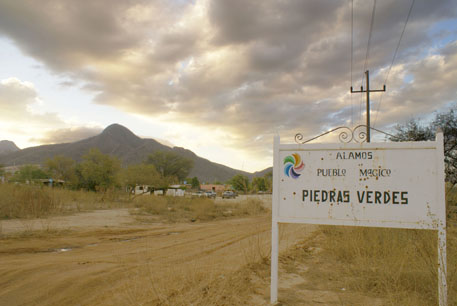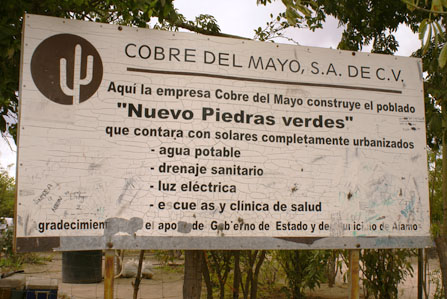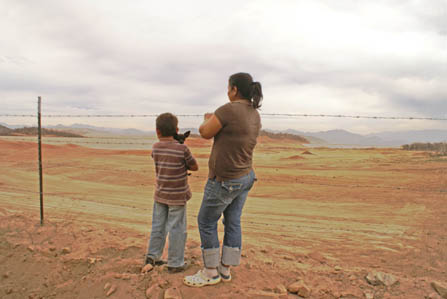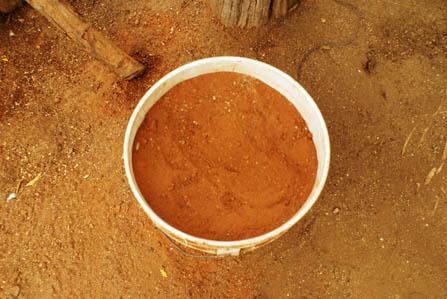OPINION
Piedras Verdes: disenchantment of a magical town

A sign identifies Nuevo Piedras Verdes as a part of the “Pueblo Mágico” (Magical Town) in Álamos, Sonora.
ÁLAMOS
Traveling through Mexico it's hard to ignore the environmental problems plaguing the country as a result of the political and economic interests of mostly foreign businesses and corporations, which, under the guise of development, invest in plans that are not necessarily beneficial to local communities. Such is the case of Piedras Verdes, a town affected by a mining company that swindled the community out of its land and has not followed through with the infrastructure projects it promised.
Piedras Verdes, which is located in the municipality of Álamos, Sonora, has been designated as a "pueblo mágico" or a magical town because of its ecotourism attractions, pleasant climate, colonial buildings, cobblestone streets, handcrafts, and cultural events.
Álamos is bordered on the north by the municipality of Rosario, on the south by the state of Sinaloa, on the east by the state of Chihuahua, and on the west by the municipalities of Huatabampo, Navojoa, and Quiriego.
The town's residents say that the territory has been exploited since 1950 by the Mina del Cinco, where copper was extracted. The town was given its name, which means “green stones or rocks” because water falling on the rock would cause oxidation to occur, bringing out the green color.
Time went by, and geological studies of the area increased, but it wasn't until the large amount of copper available for extraction was finally determined that foreign interest in mining there began.
Among these interests, the mining company Frontera Mining Corp./Cobre del Mayo, S.A. de C.V. has been exploiting the mineral since they began negotiations 9 years ago with 48 ejidatarios, who cooperatively owned the land.

At the entrance to the town, another sign stands witness to the promises made to the Nuevo Piedras Verdes residents by the mining company.
[Text reads: Cobre del Mayo, S.A. de C.V. The town of "New Piedras Verdes" is being built here by the company Cobre del Mayo. It will have completely urbanized lots with: potable water, sewage, electricity, schools and a health clinic. We thank the Sonoran State Government and the municipality of Álamos for their support]
The company began by holding meetings with the ejidatarios where it proposed various agreements that would lead to it gaining control of their lands. Don Yoyo, a man of around 75 years old says: "they told us that the mine would bring us benefits because it would be a source of employment for us and for our children". On the other hand, Señora Conchita says "many lawyers from Mexico City, gringos, and Canadians came to tell us what would be best for us because we would have work, would make money, and with the relocation they would install water lines, paved streets, and we’d have a better life."
In January 2005, they began to vacate the town of Piedras Verdes. The people took down their own roofs and dismantled their houses, removing the doors, windows and awnings; backhoes were used to knock down the walls. The majority of the people had animals, such as cows, chickens, goats, and sheep. Doña Cuca commented, "with some people, the machines arrived without any advanced warning and knocked down their fences. Their animals just wandered off to the dam or who knows where."
In February, the new housing site had been identified, and the owner of each mapped out. “Don” Ataulfo, a respected local ejidatario said, "to tell the truth, I agreed to sell my house because they offered me a lot of money. Imagine if they said to you ‘we're going to give you more than 100,000 pesos (US$8,000) for your house’, this is an amount that you couldn’t even imagine ever having in your hands. And so they come and they offer that. People get excited and also want the best for their children and for their neighbors".
On February 17, 2005, post holes were dug for the light poles in Nuevo (New) Piedras Verdes; by February 22, they had already begun to build the first foundations of the kindergarten, primary school and the tele-secondary school; on that very same day they also dug the pit for the sewage holding tank.

Residents of Nuevo Piedras Verdes look at the mine and remember longingly the old town where they lived.
On February 27th, lots were handed over to the new owners. The size and value of each property and house had been evaluated by a professional assessor, and the owner received a corresponding parcel of new land and cash.
"In order to evaluate the price of the home, some specialists came. There were people who received very little, while others were smarter and resisted selling to the mine. These people were paid a lot more than we were because they were seen as being more astute,” stressed “Don” Ataulfo.
By March 17, 2005 the contracts were signed finalizing the relocation of both homes and the town. During the months of April, May and June, electricity, a community well, and drainage was installed. The ground was scraped to mark the streets of Nuevo Piedras Verdes.
Currently, the town is suffering from water problems: nobody has water in their homes because there's not enough, and the inhabitants have to make do with a tanker truck sent daily by the mine. Some people stopped having animals because of the stench they can cause, or to avoid their livestock getting out of their corrals and into the yards of their neighbors.
The inhabitants have been affected by these sudden changes, since many of them were accustomed to living off their livestock and their sesame seed, squash and corn crops. Now they don’t plant anything.
Unfortunately, it is corrupt politicians within governmental institutions who issue the permits to carry out such predation and expropriation, and who, in collusion with business people use diverse strategies like fraud to achieve their ends.

Bucket containing a memento of the soil that made possible the construction of homes and production of food crops for residents and livestock. Now, the dirt in this image is all that remains of the old Piedras Verdes.
Studies have shown that because mining deteriorates and exhausts natural resources, it is one of the nation’s top ten ecological problems. It has also put an end to many rural cultures because the mining concessions so far granted encompass more than 133.4 million acres, or one quarter of the national territory.
Ethnoecologist Victor Toledo warns that the profits of the Canadian and Mexican companies “are obscene" in proportion to the socio-environmental conflicts that are multiplying throughout the country as water and soils are contaminated by emissions and spills of toxic chemicals including cyanide, arsenic, cadmium, lead, and chromium. They also use enormous quantities of water.
Sonora’s indigenous rural communities are not the only ones currently dealing with this problem. Sadly, other states including Chihuahua, Durango, and Zacatecas find themselves in the same situation.
In conclusion, what do you think of this problem? Knowing more now about the mining situation in our country, what alternatives or proposals come to mind? How might this situation be resolved? As a citizen, what is your opinion?
